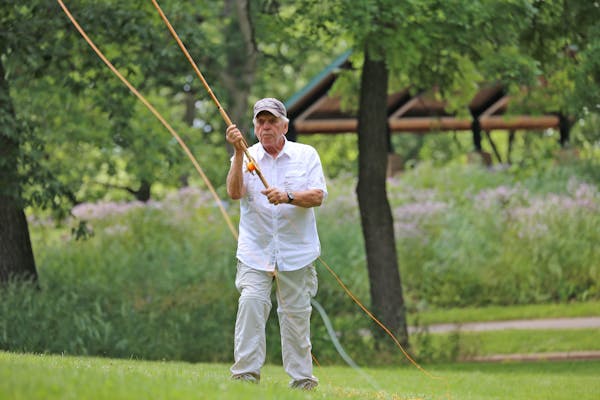Images of Minnesota's idyllic public lands this summer are mixing with visions of crowded trails and parks, careless campers and boaters, and just plain bad behavior as people seek to do the one thing they've been encouraged to do since COVID-19 struck: Find escape in the outdoors.
Stories are ever-present from government agencies, field officers, outdoors advocates and others connected to the scene. Some examples:
• Green trees cut to clear views at campsites — or just cut upon.
• Helmetless kids buzzing around roadways on the family's new all-terrain vehicle.
• Jet Skiers jetting across lakes when it's not permitted.
• Trash piled up at portages after paddlers move out.
Minnesota isn't alone. In recent weeks, reports abound of a crush of visitors — many thought to be newcomers — at hallowed places across the United States. Some national parks are seeing graffiti, feces and trash on trails, and damage to historic areas, like dirt bikers recently accused of tearing up part of Grand Teton National Park.
Ben Lawhon, education director at Leave No Trace Center for Outdoor Ethics in Boulder, Colo., said the numbers of new people recreating has amplified the issues. What might be one-time acts in other years have accumulated since the pandemic, he said, and the alarm is justified.
"So many of these people we see spending time outside either have never done so in the way they are doing now, so they're either uniformed, unskilled or engaging in careless behavior," he said.
It's a disturbing period for those who make their living in the outdoors, like Lawhon, and feel a calling to welcome people to experience, learn and just possibly champion the outdoors to future generations. Outdoors caretakers interviewed said educating people remains one of the key tools to curb the problem.
Into the forest
Ann Schwaller, who has worked in the wild for 30 years, wonders why the message of respecting the outdoors hasn't gotten through to some people.
Schwaller said there is careless and illegal behavior every year in the Superior National Forest where she works, from damage to resources to bad social etiquette. However, this year is different, said the U.S. Forest Service's forest program manager for the Boundary Waters Canoe Area Wilderness.
"We are witnessing the effects from much more degradation and damage than we usually see in an average year," she said. "And it appears our use is much higher now compared to this same time during an average year."
The data on increased visits Up North will get compiled in time. In general 50% of the 150,000 annual visitors to the BWCA come from the metro area. This summer, too, the wilderness has absorbed more traffic from paddlers who might have headed to the boundary waters of Quetico Provincial Park in Canada if the border wasn't closed.
Schwaller said the irresponsible conduct has baffled her and her colleagues and her contacts across the country.
"Why is there a disconnect between visiting a place you think is beautiful and have wanted to visit your whole life, and your treatment of it once you arrive?" she asked. "We are trying to understand where the disconnect is coming from to prevent this damage in the future.
"Why would somebody think they could leave a pile of trash at a remote campsite in the wilderness after they are done visiting the area? Or think it's OK to hack or peel live trees? Why don't they understand their responsibility in protecting the BWCA while visiting?"
Schwaller speculated that some new visitors might be used to developed campgrounds, or resorts, and the pandemic has pushed them toward new locations, uninformed about the necessities.
What is clear, she said, is visitors aren't watching the Forest Service video series online that's regarded as mandatory viewing before a trip. Also, the agency's trip planning guide isn't getting read. People head out seemingly unaware about what it means to tread lightly, to leave no trace.
"They don't seem to have the information and education or the tools necessary to protect the wilderness on their trip. It's difficult for me to put myself in their shoes and understand the mind-set," Schwaller said. "I think a lot of us are going to be studying this social issue when COVID is finally over."
Some of the uptick in bear nuisance reports is caused by campers who mishandle their food.
People have the ability to tamp down encounters with bears, said Sean Williams, a Department of Natural Resources conservation officer in Ely. He added that too many people are bringing along coolers or relying on containers that are billed as "bear-proof." The animals turn them into play things. A best practice is to hang "smellables" — food and anything that might attract attention — from a tree and out of reach.
"We've had a series of nuisance bear issues in this area, which are 100 percent avoidable and 100 percent human fault," said Williams, whose territory includes the busy Fourtown-Mudro lakes area, Little Indian Sioux River (north and south), Big Moose Lake and part of Lac la Croix.
On the water
Conservation officers have reported unprecedented boat traffic on some waters — everything from who's operating to what they're using.
Mitch Lawler, a conservation officer in Alexandria, said more people are out on new paddleboards, kayaks, Jet Skis and wake boats.
Lawler said some users aren't aware that paddleboards are considered watercraft. Those longer than 10 feet have to be registered through the DNR — just like boats. Paddleboarders also need to have a life jacket along. Jet Skiers and those on similar watercraft also have been testing the law by operating after hours. And wake boat drivers are getting warned about their gargantuan waves and their impact on fellow boaters, especially children in paddleboats or on paddleboards, and the shoreline, Lawler said. His tips:
• Know what you are riding, what it is capable of, what its limits are, and what's required to operate it.
• Leave a note where you are boating and when you are coming home. "There are 100 lakes in Douglas County. If we don't know where to start searching, that is going to be a problem," Lawler said.
• Know the law. Illegal Jet Ski use is an issue this summer. The window is 9:30 a.m. until an hour before sunset. Some riders don't take the time to learn the rules. "People think if they can see, they can go ride," Lawler said.
• Be mindful of wakes. "[Wake boats] are fairly new, but I won't issue a warning to the same person twice," he said, alluding to a high number of complaints.
• Inspect for aquatic invasive species more thoroughly. New boaters in particular are overlooking anchors and their ropes. "It's got stuff jammed in the cracks and crevasses," Lawler said.
On the ATV
Like other parts of the state, all-terrain vehicle use is up in the McGregor area, too, said conservation officer Amber Ladd. Sales are booming for manufacturers like Polaris. Also increasing are people younger than 18 who are operating them without helmets — illegally.
Rules are different depending on the roadway, the class of ATV and the operator's age. Still, Ladd said the issue is prevalent with people operating Class 2 ATVs, aka side-by-sides, who don't realize their passengers younger than 18 require helmets. She said she also is observing more Class 1 ATV riders breaking rules: from being underage without a helmet, to driving them in ways they shouldn't.
"I'm seeing them utilized as a thing for kids to do, and I am seeing them out on the roadways," Ladd said.
In general, Class 1 ATVs have to be ridden in a road ditch or on the outside slope; Class 2 must be to the far right of a road. Where they go depends on the area and road authority. Counties, for example, have different rules about use on gravel, and not every old snowmobile trail is fair game. "It just takes one 'wheeler' to go through there, and everyone thinks they can," she said.
Ladd said there also has been a volume of ATVers who haven't registered their machines or gone through the protocol of transferring ownership, blaming the pandemic for processing delays. It's an excuse that's wearing thin, Ladd said, as routine business returns.
Ladd said many people don't have their required ATV safety certificate. Anyone born after July 1, 1987, is required to have the training. Don't blame the pandemic, she added. They can meet the obligation online if they are 16 or older. "That is where they are going to learn a lot of that stuff, [the rules] are laid out there for them," she said.
Riders age 10-15 need to take the safety course online and also attend a hands-on class that covers the basics of riding responsibly.
Ladd encouraged people to self-educate, too. She said she gives out a lot of DNR rule books and business cards so people can contact her with questions. Her number is even posted at a local gas station.
"The other thing I tell people is, if you think that it might not be right, it probably isn't," she added.
Going forward
Back in Boulder, the Center for Outdoor Ethics recently released findings from research about future activity among experienced outdoors people. Some supported land managers limiting access to public lands if they continue to get tarnished. That surprised Lawhon.
Still, he returns to educating, and the center is trying to figure out its next best moves to reach outdoors newcomers when its public events are allowed again. Lawhon said research shows that telling people why their actions matter is the best way to change behavior.
"Most people, if we can tell them the right thing to do, the least impactful thing to do — and can tell them why — most people will do it," he said.
The question settling in Lawhon's mind is how to make the outdoors welcoming for everyone going forward, how to build new stewards, even as his center struggles with what it's observing.
"To not view it as an opportunity would be counter to our ultimate mission of teaching people how to enjoy the outdoors responsibly," he said. "It's not always just teaching them before they show up, it's meeting them where they are."
Bob Timmons • 612-673-7899


